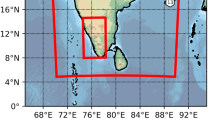Abstract
Brazilian strategic interest in the Madeira River basin, one of the most important of the southern Amazon tributaries, includes the development of hydropower to satisfy the country’s growing energy needs and new waterways to boost regional trade and economic development. Because of evidences that climate change impacts the hydrological regime of rivers, the aim of this study was to assess how global climate change and regional land cover change caused by deforestation could affect the river’s hydrological regime. To achieve this goal, we calibrated a large-scale hydrological model for the period from 1970–1990 and analyzed the ability of the model to simulate the present hydrological regime when climate model simulations were used as input. Climate change projections produced by climate models were used in the hydrological model to generate scenarios with and without regional land-use and land-cover changes induced by forest conversion to pasture for the period from 2011–2099. Although results show variability among models, consensus scenarios indicated a decrease in the low-flow regime. When the simulations included forest conversion to pasture, climate change impacts on low flows were reduced in the upper basin, while, in the lower basin, discharges were affected along the whole year due to the more vigorous land-use conversion in the Brazilian region of the basin.





Similar content being viewed by others
References
Coe MT, Costa MH, Soares-Filho BS (2009) The Influence of historical and potential future deforestation on the stream flow of the Amazon River—land surface processes and atmospheric feedbacks. J Hydrol 369:165–174. doi:10.1016/j.jhydrol.2009.02.043
Collischonn B, Collischonn W, Tucci C (2008) Daily hydrological modeling in the Amazon basin using TRMM rainfall estimates. J Hydrol (Amsterdam), p. 207
Duan Q, Sorooshian S, Gupta V (1994) Optimal use of the SCE – UA global optimization method for calibrating watershed models. Journal of Hydrology, Vol 158:265–284. doi:10.1016/0022-1694(94)90057-4
Espinoza Villar JC (2009) Spatio-temporal rainfall variability in the Amazon basin countries (Brazil, Peru, Bolivia, Colombia, and Ecuador). International Journal of Climatology 29:1574–1594. doi:10.1002/joc.1791
Geist HJ, McConnell W, Lambin EF, Moran E, Alves D, Rudel T (2006) Causes and trajectories of land-use/cover change. In: Lambin EF, Geist H (eds) Land-use and land-cover change, local process and global impacts. Springer, Berlin Heidelberg. doi:10.1007/3-540-32202-7
Guimberteau M et al (2012) Discharge simulation in the sub-basins of the Amazon using ORCHIDEE forced by new datasets. Hydrol Earth Syst Sci 16:911–35
Ley R, Casper MC, Hellebrand H, Merz R (2011) Catchment classification by runoff behaviour with self-organizing maps (SOM). Hydrology and Earth System Sciences 8:3047–3083. doi:10.5194/hessd-8-3047-2011
Marengo JA, Nobre CA, Tomasella J, Oyama MD, de Oliveira GS, de Oliveira R, Camargo H, Alves LM, Brown IF (2008) The drought of Amazonia in 2005. Journal of Climate 21:495–516. doi:10.1175/2007JCLI1600.1
Marengo JA, Chou S, Kay G, Alves LM, Pesquero J, Soares W, Santos DC, Lyra A, Sueiro G, Betts R, Betts R, Chagas D, Gomes J, Bustamante J, Tavares P (2011) Development of regional future climate change scenarios in South America using the Eta CPTEC/HadCM3 climate change projections: climatology and regional analyses for the Amazon, São Francisco and the Parana River basins. Climate Dynamics 23:1–20. doi:10.1007/s00382-011-1155-5
Marengo JA, Borma LS, Rodriguez DA, Pinho P, Soares WR, Alves LM (2013) Recent extremes of drought and flooding in Amazonia: vulnerabilities and human adaptation. American Journal of Climate Change 02:87–96. doi:10.4236/ajcc.2013.22009
Meade R, Rayol J, Conceição S, Natividade J (1991) Backwater effects in the Amazon river basin of Brazil. Environmental Geology and Water Sciences 18:105–114. doi:10.1007/BF01704664
Molinier M, Guyot JL, Oliveira E, Guimarães V (1996) Les regimes hydrologiques de l’Amazone et de ses affluents. In L’hydrologie tropicale: géoscience et outil pour le développement. IAHS Publishers: Mai, Paris; 209–222
Moriasi DN, Arnold JG, Van Liew MW, Binger RL, Harmel RD, Veith TL (2007) Model evaluation guidelines for systematic quantification of accuracy in watershed simulations. Transactions of the American Society of Agricultural and Biological Engineers 50(3):885–900
Programa de Aceleração do Crescimento—PAC (2013) Ministério do Planejamento. Governo Federal. <http://www.pac.gov.br/pub/up/relatorio/ffaff442f57973143fbd0a6c39b8ae69.pdf>
Ribeiro Neto A, Silva RCV, Collischonn W, Tucci CE (2008) Simulação na Bacia Amazônica com Dados Limitados: Rio Madeira. Revista Brasileira de Recursos Hídricos 13:47–58
Stickler CM, et al (2013) Dependence of hydropower energy on forests in the Amazon Basin at local and regional scales. [S.l.]. 2013. to the NWS distributed hydrologic model. Water Resour Res 44:W09417. doi:10.1029/2007WR006716
Tomasella J, Rodriguez DA (2014) A numerical approach for modelling sub-grid variability in tropical catchment. Hydrol Process - Submitted 2014
Tomasella J, Borma LS, Marengo JA, Rodriguez DA, Cuartas LA, Nobre CA, Prado MCR (2011) The droughts of 1996–1997 and 2004–2005 in Amazonia: hydrological response in the river main-stem. Hydrol Process (25) 1228–1242. doi:10.1002/hyp.7889
Trancoso R, Carneiro Filho A, Tomasella J, Schietti J, Forsberg BR, Miller RP (2009) Deforestation and conservation in major watersheds of the Brazilian Amazon. Environmental Conservation 36:277–288. doi:10.1017/S0376892909990373
Yilmaz KK, Gupta HV, Wagener T (2008) A process-based diagnostic approach to model evaluation: application to the NWS distributed hydrologic model. Water Resources Res 44, W09417. doi:10.1029/2007WR006716
Acknowledgments
The authors acknowledge ‘Rede GEOMA’, ‘Rede Clima’, ‘Conselho Nacional de Desenvolvimento Científico e Tecnológico’ (CNPq), HYBAM and the CMIP5 modelling groups.
Author information
Authors and Affiliations
Corresponding author
Electronic supplementary material
Below is the link to the electronic supplementary material.
ESM 1
(PDF 2062 kb)
Rights and permissions
About this article
Cite this article
Júnior, J.L.S., Tomasella, J. & Rodriguez, D.A. Impacts of future climatic and land cover changes on the hydrological regime of the Madeira River basin. Climatic Change 129, 117–129 (2015). https://doi.org/10.1007/s10584-015-1338-x
Received:
Accepted:
Published:
Issue Date:
DOI: https://doi.org/10.1007/s10584-015-1338-x




